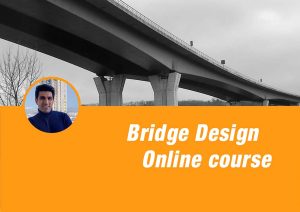
The online course is divided into five major chapters:
1.Superstructures design
2.Substructures design
3.Specifications according to the to the AASHTO and FHWA codes
4.Bridge loading
5.Software Analysis
Course Curriculum
- The superstructure comprises all the components of a bridge above the supports.This course devoted 3 types of superstructures
- Steel superstructures such as steel I girders and steel box girders
- Concrete superstructures such as solid and void cast-in-place slabs, precast I or T girders with cast-in-place slabs
- Concrete Post Tension Superstructure, such as precast I Shape concrete sections
2.The substructure consists of all elements required to support the superstructure and overpass roadway
- Abutments or end supports (earth-retaining structures that support the superstructure and overpass roadway at the beginning and end of a bridge) such as MSE and Cantilever abutments
- Piers are structures that support the superstructure at intermediate points between the end supports.
- Bearings: are mechanical systems that transmit the vertical and horizontal loads of the superstructure to the substructure and accommodate movements between the superstructure and the substructure.
- Footing: As bearings transfer the superstructure loads to the substructure, so in turn do the abutment and pier footings transfer loads from the substructure to the subsoil or piles. A footing supported by soil without piles is called a spread footing, and if the soil under a footing cannot provide adequate support for the substructure (in terms of bearing capacity, overall stability, or settlement), support is obtained through the use of piles, which extend down from the footing to a stronger soil layer or to bedrock, The sessions are focused on both types of footing.
3. In this course, specifications covered are AASHTO Standard, LRFD, FHWA, Caltrans, and in some cases we will investigate other specifications
4. In this part, the focus is on permanent loads (dead loads and superimposed dead loads), traffic loading, thermal loading, wind load, and seismic load according to the bridge specifications mentioned in Part 3.
5. Software Analysis: During this course, we will utilize SAP 2000 and CSI Bridge to simulate and analyze each superstructure specified in Part 01, as well as validate the results after analysis against the specifications mentioned in Part 3.
In addition to the mentioned explanation, some other parts of the bridge will be covered, such as the approach slab, link slab design, friction shear, and so on.
The entire session is in English
For more Information contact us in the following ways:
Whats App: +989224328717
Email: ee.learning.ir@gmail.com